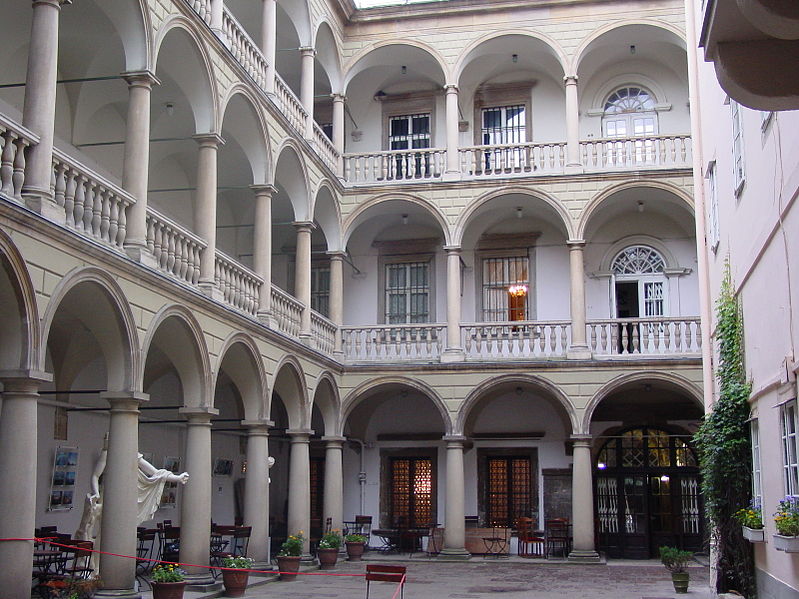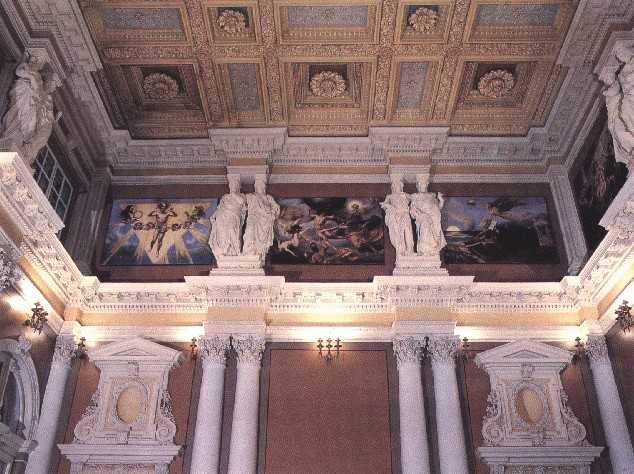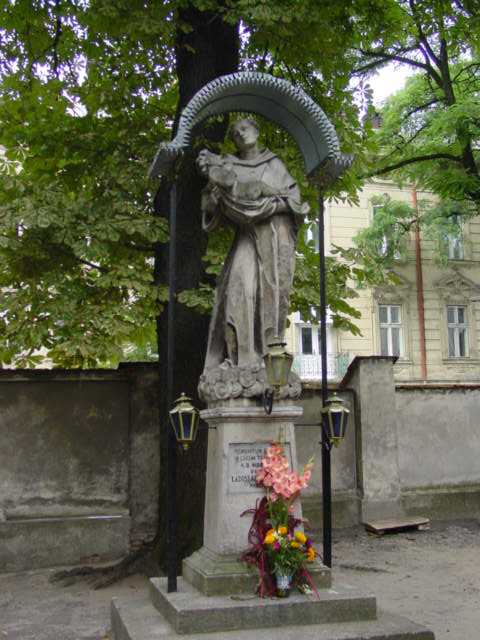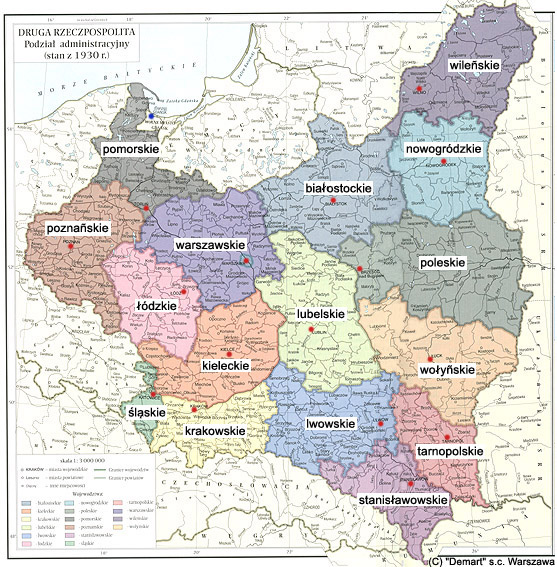The first mention of Lwow in early chronicles is from 1256, although archeological excavation in 1993 revealed that the first settlements appeared in the 6th century.
1356 - King Casimir III of Poland granted the Magdeburg rights which implied that all city matters were to be resolved by a council elected by the wealthy citizens.
1444 - Lwow was granted with the staple right, which resulted in city's growing prosperity and wealth, as it became one of major trading centers on the merchant routes between Central Europe and Black Sea region. It was also transformed into a one of main fortresses in the Kingdom of Poland.
Sixteenth and seventeenth century - the period was marked by artistic and cultural flowering (elements of Western art of the Renaissance, Mannerism and Baroque, with Byzantine elements, Armenian or even oriental). Polonized Italians, Germans and Armenians, as well as native artists - Polish were working together to change Lwow into one of the foremost artistic capitals of the Polish–Lithuanian Commonwealth. The sixteenth century has left such monuments of art, like the Korniaktowska Tower with Wołoska Orthodox, chapel Boim, the Jesuits and Bernardine churches, houses - Black and Royal.
1658 - Polish citizens can inherit and own the land, send deputies (like Krakow and Wilno) to the parliaments and the general election.
1795-1914 - Most important centers of Polish culture were (beside the longest independent Krakow) Warsaw under Russian rule, Lwow under Austrian rule and Poznan under Prussian rule.
1918-1939 - After Poland was reborn and regained its independence, the main centers of Polish science and culture were: Jagiellonian University, Academy of Sciences in Krakow, Jan Kazimierz University in Lwow, University of Technology in Lwow, also University in Warsaw and University of Technology in Warsaw. Academic centers in Wilno, Poznan, Lublin, and two specialized universities: University of Mining - Metallurgy in Krakow and Warsaw Agricultural University in Warsaw made a significant contribution in higher education.
List of the largest Polish cities by population (1939, in Thousands):
1. Warszawa - 1289
2. Lodz - 672
3. Lwow - 340
4. Poznan - 272
5. Krakow - 259
6. Wilno - 215
red line - borders of Poland (1918-1945)
blue line - borders of Poland, which should be accepted after 1945 according to the Curzon Line (including Eastern Prussia), but because of the fault of the Allies (primarily U.S.), Stalin outlined his version of the Polish eastern border on the basis of the Hitler-Stalin pact (1939). Stalin decided that he wanted Königsberg (Eastern Prussia) as a year-round warm water port for the Soviet Navy (with U.S. and Great Britain approval). However Lwow was to be granted to Poland, but because of the Polish communists such as Bolesław Bierut, Wanda Wasilewska, etc. it remained in the borders of USSR.
pink colour - current map of Poland

It is worth mentioning that Lodz, Krakow, Lwow and Wilno were not destroyed by WW2.
In Lwow were born, lived famous Poles...I will only mention a few of them. The famous mathematician Stefan Banach, Polish writer of catechism Władysław Bełza ("Kto ty jesteś? Polak mały"
 , traveler Benedykt Dybowski, poet Seweryn Goszczyński, illustrator and painter Artur Grottger, historian Karol Szajnocha. Also, Maria Konopnicka, Maryla Wolska, Gabriela Zapolska, Leopold Staff, Stanisław Lem, Zbigniew Herbert, Witold Pyrkosz, Mikołaj Biernacki, Aleksander Fredro, Jan Kasprowicz, Beata Obertyńska, Kornel Makuszyński, Kazimierz Górski, Wojciech Kilar and many, many more.
, traveler Benedykt Dybowski, poet Seweryn Goszczyński, illustrator and painter Artur Grottger, historian Karol Szajnocha. Also, Maria Konopnicka, Maryla Wolska, Gabriela Zapolska, Leopold Staff, Stanisław Lem, Zbigniew Herbert, Witold Pyrkosz, Mikołaj Biernacki, Aleksander Fredro, Jan Kasprowicz, Beata Obertyńska, Kornel Makuszyński, Kazimierz Górski, Wojciech Kilar and many, many more.
Photos of Lwow:
http://www.skyscrapercity.com/showthread.php?t=1466163
www.skyscrapercity.com/showthread.php?t=610482
In recent years Lwow begins to regain its former beauty. Many monuments are renovated due to Euro 2012.
The Lwow University - was founded on January 20, 1661 by the King John II Casimir of Poland ("the honour of the Academy and the title of the University"
 . It is one of the oldest in Eastern Europe and the fourth oldest university founded in the lands of the Commonwealth.
. It is one of the oldest in Eastern Europe and the fourth oldest university founded in the lands of the Commonwealth.

The Main Train Station in Lwow - is one of the most notable pieces of Art Nouveau architecture. It was designed by Polish architect and a graduate of the Lwów Technical Academy Władysław Sadłowski and opened to the public in 1904.


Grand Theatre in Lwow - is an opera house and theatre. An independent jury unhesitatingly chose the design by Zygmunt Gorgolewski, the Director of the Lwów higher art-industrial school. Grand Theatre in Lwow was opened on October 4, 1900. The cultural elite—painters, writers, and composers, as well as delegations from various European theatres—attended the opening festivities. Among the guests attending the ceremony were Henryk Sienkiewicz (writer), Ignacy Jan Paderewski (composer), Henryk Siemiradzki (painter), Godzimir Małachowski (the president of Lwów) and governor Leon Piniński.
The theatre, beautifully decorated inside and outside, became a centrefold of the achievements in sculpture and painting of Western Europe at the end of the 19th century. The internal decoration was prepared by some of the most renowned Polish artists of the time. Among them were Stanisław Wójcik (allegorical sculptures of Poetry, Music, Fame, Fortune, Comedy and Tragedy), Julian Markowski, Tadeusz Wiśniowiecki, Tadeusz Barącz, Piotr Wojtowicz (relief depicting the coat of arms of Lviv), Juliusz Bełtowski (bas-relief of Gorgolewski) and Antoni Popiel (sculptures of Muses decorating the façade).
Among the painters to decorate the interior were Tadeusz Popiel (staircases), Stanisław Rejchan (main hall), Stanisław Dębicki, Stanisław Kaczor-Batowski and Marceli Harasimowicz (foyer). The team supervised by the abovementioned artists included further painters, among them Aleksander Augustynowicz, Ludwik Kohler, Walery Kryciński, Henryk Kuhn, Edward Pietsch, Zygmunt Rozwadowski, Tadeusz Rybkowski and Julian Zuber. The main curtain was decorated by Henryk Siemiradzki.


Old Town in Lwow - historic center of Lwow, part of the city founded in 1356 by King Casimir III of Poland. Around the square, there are 44 tenement houses, which represent several architectural styles, from Renaissance to Modernism. Since 1998, the United Nations Educational, Scientific and Cultural Organization (UNESCO) lists Lwow's historic center as part of "World Heritage".



The fountains and sculptures of Neptune, Adonis, Diana and Amphitrite are all encircled by the square's old walls (sculptor: Hartman Witwer, approx. 1800).



King John III Sobieski Palace, also called "Little Wawel" - it was originally built in 1580, for a Greek merchant Konstanty Korniakt. In 1640, it was purchased by Jakub Sobieski and inherited by King John III Sobieski. The Polish-Lithuanian ruler remodelled it into a palace-style residence, with spacious rooms and an audience hall. Since 1908, a historical museum of the city has been located here.


The Black House - is a remarkable Renaissance building on the Lwow Market Square. It was built for Italian tax-collector Tomaso Alberti in 1577. The architect was Piotr Krasowski. Jan Lorencowicz, having acquired the house in 1596, added another storey and opened one of the town's first pharmacies on the ground floor. The front elevation of the house is created from sandstone, which darkened through the years, making it architecturally significant. Since 1926 it has been part of the Historic City Museum.

The Archcathedral Basilica of the Assumption of the Blessed Virgin Mary (called simply the Latin Cathedral) - is located in city's Old Town, in the south western corner of market square. In 1360 the king Casimir III of Poland founded the construction of the present day church, built in Gothic style, for a cathedral of the newly created Latin diocese. The cathedral witnessed many significant events and was visited by several Polish kings, most notably John II Casimir, who in the Cathedral entrusted the Polish-Lithuanian Commonwealth under the care of the Blessed Virgin in what came to known as the Lwów Oath.


The Potocki Palace - is a bright example of mature historicism architecture and one of the most interesting architectural landmarks of Lwow. It was designed by French architect Louis d’Overnu at the order of Polish nobleman Alfred II Joseph Potocki (1817-1889). The construction lasted from 1888 to 1890 under the supervision of Lwow architect Julian Cybulski who also introduced some changes.

Lwow Polytechnic - is the largest scientific university in Lwow. Since its foundation in 1844, it was one of the most important centres of science and technological development in Central Europe. In the interbellum period, the Polytechnic was one of the most important technical colleges in Poland, together with the Warsaw Polytechnic. Julian Zachariewicz was elected as the construction superintendent.
Notable alumni
- Stefan Banach (Mathematician)
- Kazimierz Bartel (Prime minister of Poland)
- Władysław Sikorski (Polish general and prime minister)



The Roman Catholic church of St. Mary Magdalene in Lwow - the seventeenth century Baroque Roman Catholic church designed by Wojciech Kielar and Jan Godny. The founder of the church in 1600 was the noblewoman Anna Pstrokońska.

The Baroque Church of St. Anthony - Roman Catholic Church in Lwow. In 1617 the city of Lwow magistrate agreed to the foundation of the second Conventual Franciscan monastery. King of Poland Sigismund III Vasa approved the decision of the magistrate. Construction began in 1618 and completed in 1630. Church represents a harmonious combination of architecture, sculpture, and nature.


The Lyczakowski cemetery - is one of the oldest graveyards in Europe, dating from 1786. For comparison: Powązki in Warsaw was opened in 1790, the Rossa Cemetery in Vilnius was officially opened in 1801 and Rakowicki in Krakow, Père-Lachaise in Paris were opened in 1803. The oldest graves are from the eighteenth century. On some tombes we can see Empire and Neo-Classical sculptures by Anton, Jan and Leopold Schimserów and Hartman Witwer. More recent graves were built by Tomasz Dykas, Abel Marie Perier, Leonard Marconi, Julian Zachariewicz, Parys Filippi, Cyprian Godebski, Tadeusz Barącz, B. Wiktor, St. R. Lewandowski, St. K. Ostrowski, Julian Markowski and others. Lwow's most prominent graveyard is now an open air museum and considered by many to be even more than that. It is now a major Lwow tourist attraction, a "gallery of art work", featuring graves of many renowned personalities. Of course, the most important aspect of the cemetery is the variety of beautiful gravestones in memorial to famous soldiers, poets, artists, writers, composers, historians, etc.





The Chapel of Boim family - is a small shrine in Lwow, located just outside the Latin Cathedral, in what used to be known as the Chapter Square. Built between 1609 and 1615, the chapel was originally located in what used to be the city's main cemetery. Founded by mighty merchants, Jerzy Boim (also, Secreatry of the King of Poland, Stefan Batory) and his wife Jadwiga Niżniowska, the Boim chapel was finished by their son, Paweł Jerzy Boim. It bears strong resemblance to the Sigismund's Chapel at the Wawel Cathedral in Kraków.


The Roman Catholic church of St. Andrew with The Bernardine monastery in Lwow - is located in the city's Old Town, south of the market square. It was built between 1600-1630 according to plans of Polish architect Paweł Rzymianin in place of the old, wooden church. It is one of the most beautiful churches in the city. It combines the best elements of Italian and Flemish Mannerism. Church impresses with its richly decorated façade.

Kampian's Chapel - one of the greatest Renaissance chapels in Lwow's Latin Cathedral. It was built for the patricians of Lwow: Paweł Kampian (physician and mayor) and his son Marcin (physician, councilor and mayor). It was formed into mausoleum of Kampianów, Grozwajerów and Ostrogórskich families.

Bandinelli Palace - is a late Renaissance townhouse facing Market Square in Lwow. It was built in 1589 by a pharmacist Jarosz Wedelski, and in 1634 it was bought by a courtier of Polish king Sigismund III Vasa, Roberto Bandinelli. The house was considerably renovated in 1737-1739. Polish poet, patriot and political writer Kornel Ujejski lodged here.

To be continued...
[ Ostatnio edytowany przez: Radek_z_NI 08-12-2011 09:09 ]












 Wczytuję dane...
Wczytuję dane...